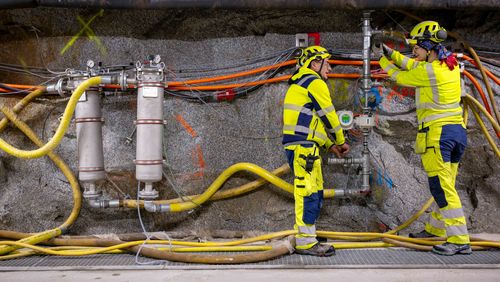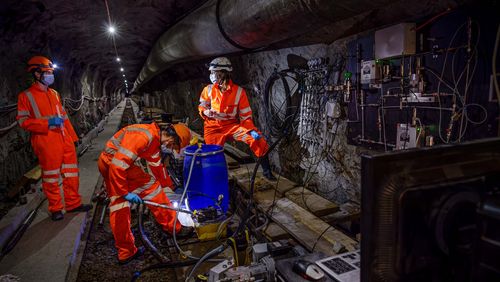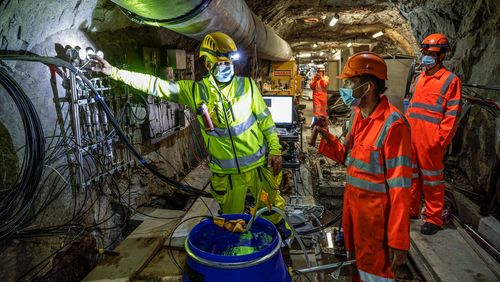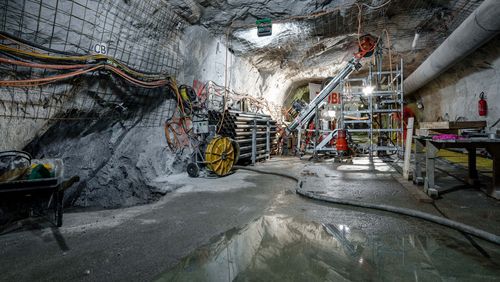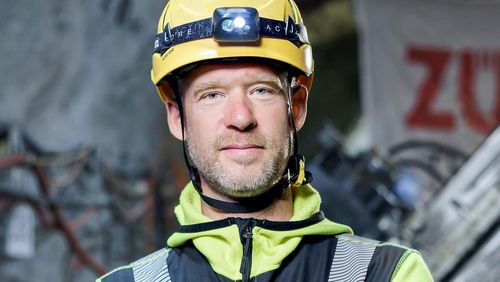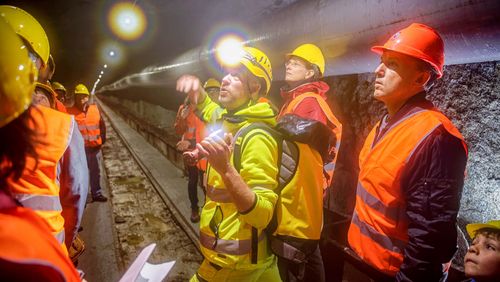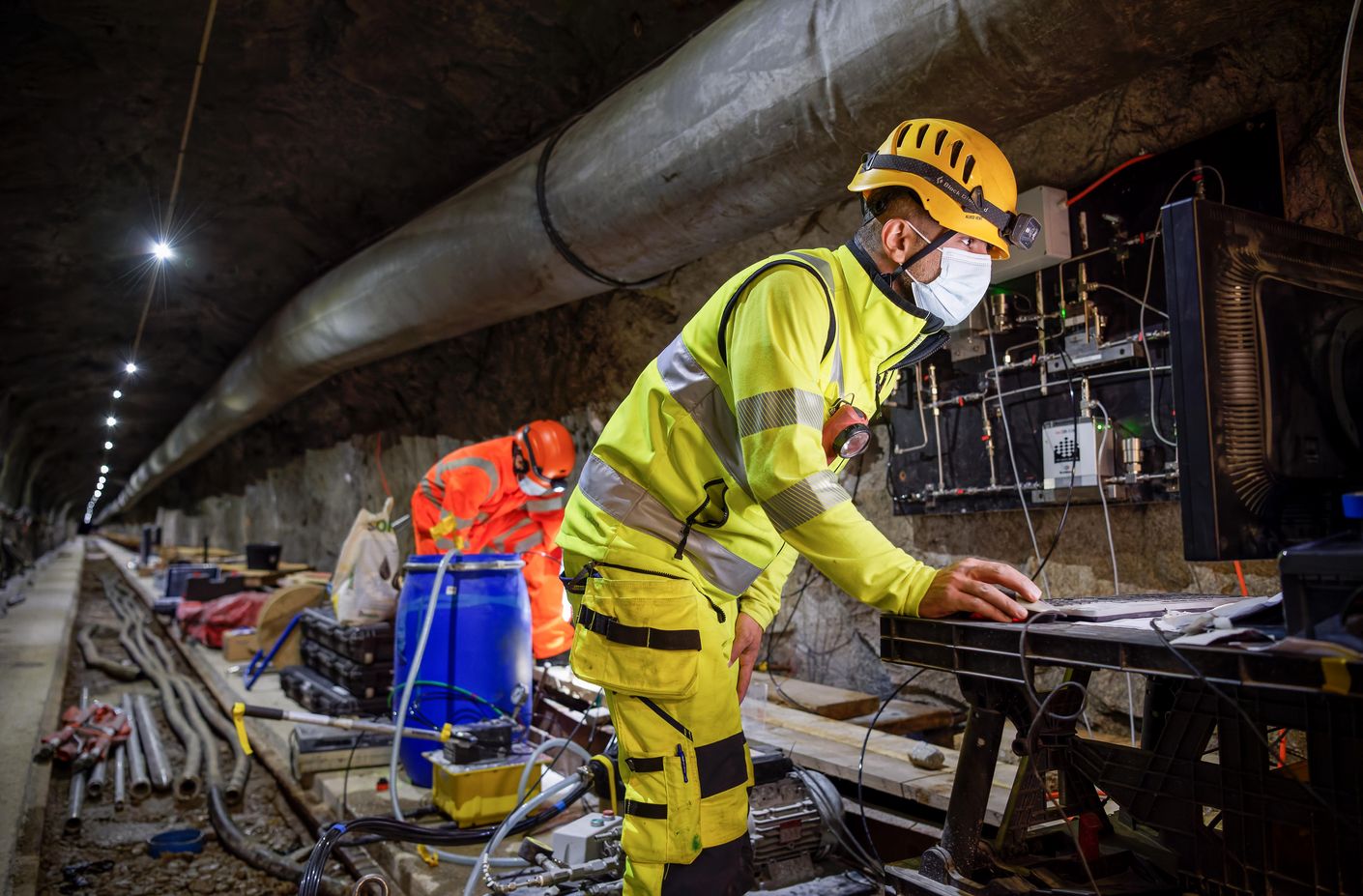
A growing enterprise
Constructed in 2018, the Bedretto Underground Lab attracts researchers from all over the world. This past year, the unique facility was enlarged to allow even more experiments to be conducted: an additional tunnel was accessed for the subterranean research projects—once again with funding from the Werner Siemens Foundation.
Construction company Fretus began work on the extension in January 2022 and, until April, improved the infrastructure in a section covering 2.9 of the tunnel’s overall 3.1 kilometres. Due to another long-term commitment, however, it was autumn before all work was completed. During the building hiatus, researchers took the opportunity to drill exploratory boreholes in what would be the new, second part of the lab.
There, the researchers studied methods of drilling deep holes for energy storage at medium depths that won’t trigger discernible earthquakes. This preliminary work was also necessary for drilling additional boreholes and creating a planned side tunnel. In addition, another research project financed by the Werner Siemens Foundation has commenced: Mitigating Induced Seismicity for Successful Geo-Resources Application (MISS). The objective of MISS is to discover ways of keeping the subsurface immobile when fluids or gases are injected. For this work, the researchers stimulate the rock layers over a period of forty-eight hours by injecting water at four points in the first borehole, then observe the connection to the second borehole, where the heated water rises.
International interest
The new testing environment in the Bedretto Underground Lab will be ready for operation at the start of 2023. “We’ll have double the capacity for further research into deep geothermal energy,” says project leader Domenico Giardini. National and international research groups and organisations have shown strong interest in the facilities, with roughly two dozen projects currently underway or in planning. The European Research Council, too, is contributing to research in the Bedretto Underground Lab—in the form of the largest ERC grant ever awarded to an earth science project. In addition, three new EU projects were launched in 2022, and an international advisory board was constituted to oversee these research partnerships. Members include representatives from the GFZ German Research Centre for Geosciences at the Helmholtz Centre Potsdam, EGS Collab at the US Office of Energy Efficiency and Renewable Energy, and the research programme Geothermal Energy at the Swiss Federal Office of Energy. There are also plans to enlarge the board of the Bedretto Underground Lab.
Underground heat reservoirs
The growth in all these project areas is no coincidence: geothermal energy is looked on as a key component in future climate-neutral and diversified energy policies. Indeed, by 2050, Switzerland hopes to use geothermal energy to cover 25 percent of the country’s heating needs. Russia’s war in Ukraine and the related surge in energy prices have played a significant role in the fact that most European countries have begun reassessing their energy policies—in particular their dependence on Russian gas—and are seeking to invest in more autonomous energy production.
Heat reservoirs for energy storage located at medium depths are one way of achieving this, and researchers in the Bedretto Underground Lab are currently testing feasibility. Their idea is to create heat reservoirs in various locations at depths of around 1500 metres. During the energy-rich summer months, water can be pumped into the reservoirs, where it is heated. The heat stored in these reservoirs would then be available for generating power in winter.
This method of exploiting geothermal energy has two major advantages. First, costs would be reduced drastically, as drilling to a medium depth of 1500 metres is much less expensive than constructing reservoirs at depths as low as 5000 metres, which is currently the practice for deep geothermal power plants. Second, in summer, the energy to pump the water into the rock is available in great supply—and consequently much less expensive.
![[Translate to English:] Die Geobiologin Cara Magnabosco sucht im BedrettoLab nach Mikroorganismen, die tief unter der Erdoberfläche leben. Sie könnten Hinweise darauf geben, wie Leben entstehen konnte.](/fileadmin/_processed_/1/c/csm_01-WSS-NEWS-Bedretto_DSC8324_c8ea4a52fd.jpg)
